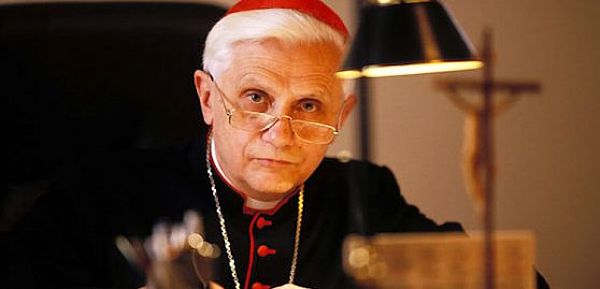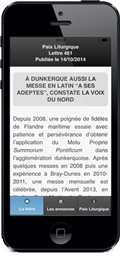Letter 122 published 9 February 2022
THE MASS WAS NEVER FORBIDDEN

The election of John Paul II in 1978 marked a turning point in an attempt to regain control in the wake of the Council, even if it was extremely timid.* On November 18, 1978, one month after his election, at the initiative of Cardinal Siri, John Paul II received Archbishop Lefebvre in the presence of Cardinal Seper.
1981: Cardinal Ratzinger takes the liturgical question in hand
The ensuing change of direction was largely due to the fact that John Paul II called the Archbishop of Munich, Cardinal Ratzinger, to Rome in 1981and entrusted him with the position of trust par excellence in those times of great doctrinal confusion: Prefect of the Congregation for the Doctrine of the Faith. In 1985, the Cardinal published his Interview on the Faith, setting out his thinking in the theological and disciplinary fields. This he summarized with the word "restoration," which, as he clearly explained, must be understood within a conciliar framework and not in a retrograde sense. Or at least, not explicitly retrogade.
On the other hand, on liturgical questions, the prospect of a certain return to the past was clearly on the cardinal's mind. It should be noted that Joseph Ratzinger, former peritus of Cardinal Frings, Archbishop of Cologne, one of the major figures of the council majority, had sounded his first liturgical alarm in a lecture he gave in Münster, in 1966, when still a professor, and then in another in Bamberg, at the Katholikentag (the gathering of German Catholics organized every two years), the same year. He attacked the "new ritualism" of the liturgical experts, who were replacing the old customs with the fabrication of suspicious "forms" and "structures," such as the obligatory versus populum stance. For the first time in his life, the former expert of the majority at Vatican II was called "conservative" (by Cardinal Döpfner). At the end of 1966 he was appointed professor at the Catholic School of the University of Tübingen, where he witnessed the German May '68, i.e., the Marxization of a university (Ernst Bloch dominated the teaching staff), whose Catholic School had largely integrated Bultmann's demythologizing theology.
In 1969 he accepted a position as professor of dogmatic theology and history of dogma in Regensburg, at the same time as he was appointed a member of the International Theological Commission. It was also in Regensburg that he became acquainted with the liturgical historian Klaus Gamber, who had remained faithful to the traditional Mass. There, on the banks of the Danube, a new shock awaited him after the first stage of the reform and the revolution of 1968: the completion of the liturgical upheaval. Although he agreed with many aspects of the reform, he found its radical nature unbearable, and his negative judgment was reinforced by his long conversations with his colleague Gamber during their daily walks. "The old building has been destroyed in order to build a new one," he later wrote.
It was at this time that Joseph Ratzinger's complex thinking on liturgical matters crystallized. It was that of a centrist who was fundamentally conciliar, but attentive to the traditionalist voices raised by university friends: Professor Klaus Gamber; later, Professor Robert Spćmann and Professor Heinz-Lothar Barth. It was also in Regensburg, in 1977, that he was appointed by Paul VI, who was increasinegly afraid of "the smoke of Satan in the Church," to one of the most important sees in Germany, that of Munich and Freising. John Paul II removed him from this position and named him head of the Congregation for the Doctrine of the Faith on November 25, 1981.
1982: Questioning the abrogation of the old missal
Everyone now knew how impossible it was to bring to heel the challenge to the reform, in both doctrine and liturgy, issuing from a whole section of the Church, the highest figure of which was Archbishop Lefebvre, former Archbishop of Dakar. John XXIII and Paul VI, as "enlightened princes", had presided over the end of the Tridentine model of the Roman Church. But as a result, the Tridentine disciplinary corset no longer constrained anyone, not even the defenders of Trent, the traditionalists.
It is worth noting that Annibale Bugnini himself, while exiled as nuncio in Tehran, had addressed a letter to Cardinal Villot, Paul VI's Secretary of State, in 1976, in which he proposed that, while safeguarding the principle of a mandatory Paul VI Mass, the Mass of St. Pius V could be celebrated under certain conditions, in specific churches for groups having difficulties with the new Ordo Missć.
This is precisely what Joseph Ratzinger proposed when he arrived in Rome. He organized an inter-dicastery meeting in the Palazzo del Sant'Officio on November 16, 1982, to discuss the liturgical question and the Lefebvrist question. The participants in the November 16, 1982 meeting were: Cardinal Sebastiano Baggio, Prefect of the Congregation for Bishops; Cardinal William W. Baum, Archbishop of Washington; Cardinal Agostino Casaroli, Secretary of State; Cardinal Silvio Oddi, Prefect of the Congregation for the Clergy; Cardinal Joseph Ratzinger, Prefect of the Congregation for the Doctrine of the Faith; and Archbishop Giuseppe Casoria, pro-Prefect of the Congregation for Divine Worship and the discipline of the Sacraments. All the participants in this meeting affirmed that, since "the full juridical validity of the abrogation of the old missal is in doubt," the "old" Roman missal should be "admitted by the Holy See throughout the Church for Masses celebrated in Latin." This in 1982, 25 years before Summorum Pontificum!
1984 : Quattuor abhinc annos
It was not until 1984, however, that such a permission was granted. On April 19, 1984, a new meeting took place between Cardinals Casaroli, Ratzinger, and Casoria.
A letter from Cardinal Casaroli, Secretary of State, dated March 18, 1984, to Cardinal Casoria, Prefect of the Congregation for Divine Worship, asked him to prepare a decree reflecting this. He invoked the precedent set by the permission granted by Paul VI to England and Wales in 1971, and specified that "an absolute prohibition [of the previous missal] could not be justified from either the theological or the liturgical point of view." The result was the circular letter Quattuor abhinc annos from the Congregation for Divine Worship on October 3, 1984, which granted diocesan bishops the faculty of using an indult by which the faithful who so requested could benefit from the Mass celebrated according to the Roman Missal in its 1962 typical edition.
Cardinal Stickler revealed that in 1986 Cardinal Ratzinger called another meeting of nine cardinals to ask them once again whether or not they thought the Tridentine Mass had been legally abrogated: eight out of nine thought that it had not, but all of them unanimously agreed that a priest could not be forbidden to say it. In 1986, 21 years before Summorum Pontificum!
Four years later, after the June 30, 1988 consecrations by Archbishop Lefebvre of four bishops without apostolic mandate, Bishops Galarreta, Tissier de Mallerais, Williamson, and Fellay, a new text was published: the motu proprio Ecclesia Dei adflicta of July 2, 1988. It provided that priests of the traditional rite could constitute institutes dedicated to the traditional liturgy. It created a Pontifical Commission, the Ecclesia Dei Commission, on which these institutes were to depend, and which was also responsible for regulating the authorizations given by bishops to use the Tridentine Missal in their dioceses.
The prelates who from 1988 on began to agree to celebrating occasionally according to the Tridentine missal became relatively numerous. A certain number of them soon appeared to be protectors of this mode of celebration. Thus, to speak only of the Cardinals of the Curia, one can mention Cardinals Oddi, Palazzini, Stickler, then Ratzinger himself, Medina, Castrillón, and later Burke, Rodé, Ranjith, Cańizares, Cordes, and Sarah. It is quite remarkable that three of them, Medina, Cańizares, and Sarah, were prefects of the Congregation for Divine Worship.
***
Nineteen years would elapse before the promulgation of the motu proprio Summorum Pontificum on July 7, 2007. Under the pressure of a challenge that could not be crushed, and which had now gained a hearing at the highest levels, the supreme legislator gradually had come to interpret the prescriptions of the Missale Romanum of 1969 as non-binding.
* The following presentation follows abbé Claude Barthe's book, La messe de Vatican II. Dossier historique (Via Romana, 2018).




